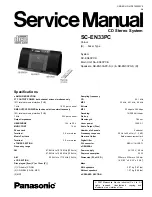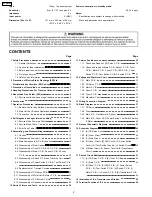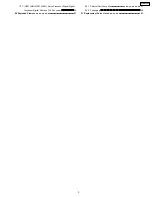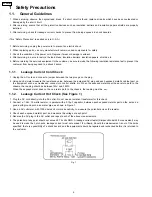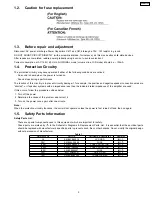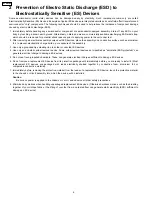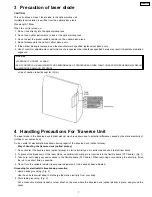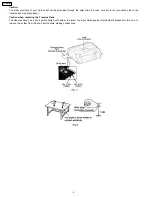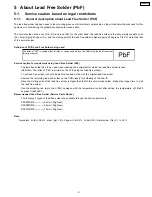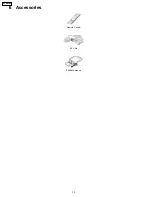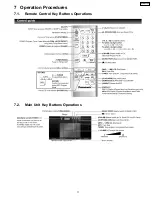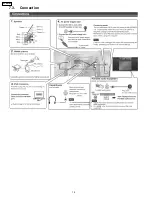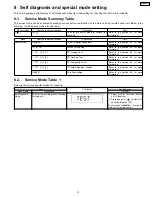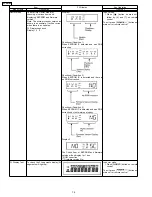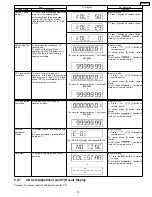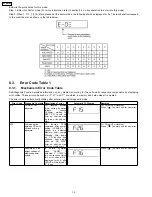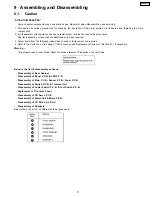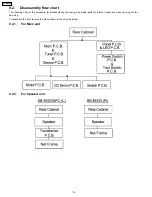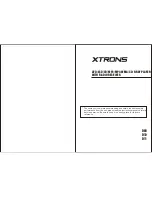
1 Safety Precautions
1.1. General Guidelines
1. When servicing, observe the original lead dress. If a short circuit is found, replace all parts which have been overheated or
damaged by the short circuit.
2. After servicing, ensure that all the protective devices such as insulation barriers and insulation papers shields are properly
installed.
3. After servicing, check for leakage current checks to prevent from being exposed to shock hazards.
(This “Safety Precaution” is applied only in U.S.A.)
1. Before servicing, unplug the power cord to prevent an electric shock.
2. When replacing parts, use only manufacturer’s recommended components for safety.
3. Check the condition of the power cord. Replace if wear or damage is evident.
4. After servicing, be sure to restore the lead dress, insulation barriers, insulation papers, shields, etc.
5. Before returning the serviced equipment to the customer, be sure to make the following insulation resistance test to prevent the
customer from being exposed to a shock hazard.
1.1.1. Leakage Current Cold Check
1. Unplug the AC cord and connect a jumper between the two prongs on the plug.
2. Using an ohmmeter measure the resistance value, between the jumpered AC plug and each exposed metallic cabinet part on
the equipment such as screwheads, connectors, control shafts, etc. When the exposed metallic part has a return path to the
chassis, the reading should be between 1M
W
and 5.2M
W
.
When the exposed metal does not have a return path to the chassis, the reading must be
.
1.1.2. Leakage Current Hot Check (See Figure 1)
1. Plug the AC cord directly into the AC outlet. Do not use an isolation transformer for this check.
2. Connect a 1.5k
W
, 10 watts resistor, in parallel with a 0.15µF capacitor, between each exposed metallic part on the set and a
good earth ground such as a water pipe, as shown in Figure 1.
3. Use an AC voltmeter, with 1000 ohms/volt or more sensitivity, to measure the potential across the resistor.
4. Check each exposed metallic part, and measure the voltage at each point.
5. Reverse the AC plug in the AC outlet and repeat each of the above measurements.
6. The potential at any point should not exceed 0.75 volts RMS. A leakage current tester (Simpson Model 229 or equivalent) may
be used to make the hot checks, leakage current must not exceed 1/2 milliamp. Should the measurement is out of the limits
specified, there is a possibility of a shock hazard, and the equipment should be repaired and rechecked before it is returned to
the customer.
Fig. 1
4
SC-EN33PC
Summary of Contents for SC-EN33PC
Page 10: ...6 Accessories Remote Control AC Cord FM AM Antenna 10 SC EN33PC ...
Page 12: ...7 3 Connection 12 SC EN33PC ...
Page 30: ...11 1 Check and Repair of CD Servo P C B 30 SC EN33PC ...
Page 33: ...12 2 CD Servo P C B 12 3 Motor P C B 12 4 Panel P C B 12 5 Tuner P C B 33 SC EN33PC ...
Page 34: ...12 6 Waveform Chart 34 SC EN33PC ...
Page 35: ...13 Wiring Connection Diagram 35 SC EN33PC ...
Page 36: ...36 SC EN33PC ...
Page 37: ...14 Block Diagram 14 1 CD Servo SC EN33PC 37 ...
Page 38: ...14 2 Tuner SC EN33PC 38 ...
Page 39: ...14 3 Main 1 2 Transformer Sensor SC EN33PC 39 ...
Page 40: ...14 4 Main 2 2 Panel LED Power Switch Tact Switch Switch Motor SC EN33PC 40 ...
Page 42: ...42 SC EN33PC ...
Page 44: ...16 1 A CD Servo Circuit SC EN33PC 44 ...
Page 45: ...16 2 B Tuner Circuit SC EN33PC 45 ...
Page 46: ...16 3 C Main Circuit SC EN33PC 46 ...
Page 47: ...SC EN33PC 47 ...
Page 48: ...SC EN33PC 48 ...
Page 50: ...16 5 I Motor Circuit J Sensor Circuit K Transformer Circuit SC EN33PC 50 ...
Page 52: ...17 1 A CD Servo P C B B Tuner P C B SC EN33PC 52 ...
Page 53: ...17 2 C Main P C B SC EN33PC 53 ...
Page 57: ...20 Exploded Views 20 1 Cabinet Parts Location SC EN33PC 57 ...
Page 58: ...SC EN33PC 58 ...
Page 59: ...20 2 Packaging SC EN33PC 59 ...
Page 60: ...SC EN33PC 60 ...

